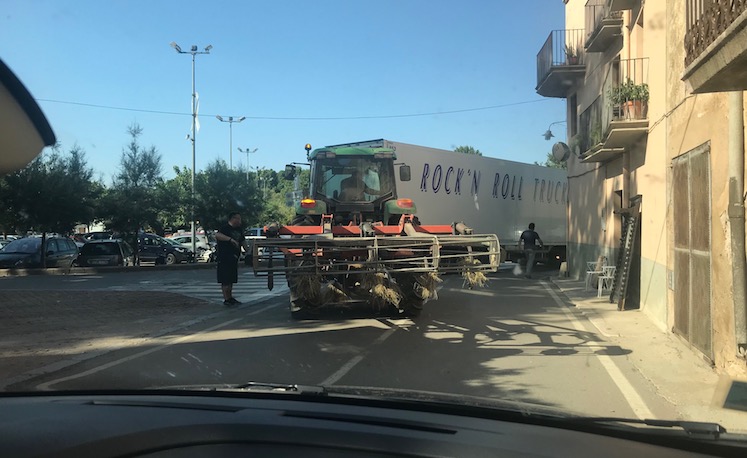A version of this article is published by the Financial Times.
We had just arrived in Peralada, in the far north-eastern corner of Spain, when a sight confronted us that seemed to sum up this small village.
I had mistakenly turned left on the road encircling the high walls round the medieval Castell de Peralada, the lake, the impressive restaurant and the concert venue where we and 1,400 others were to dance to Carlos Santana until late that evening, when I suddenly had to apply my brakes very fast.

In front of us was a tractor with a baler on the back. It was trying to turn left as a vast pantechnicon, with Rock ‘N’ Roll Trucking emblazoned on its sides in purple, was trying to reverse into the castle’s grounds across the tractor’s path. Three helmeted cyclists appeared on either side of the tractor whose driver was signalling to me to reverse. I checked my rear view mirror and spotted another cyclist right behind. Happily, thanks to much authoritative waving on the part of a villager, this all cleared eventually. This was the height of the festival season in Peralada.
That evening we were back at the castle. Having walked along an avenue of extremely tall trees lined with booths selling glasses of wines from Perelada (the Castilian spelling of Peralada), we came to a sight that could have been straight out of Disneyland. There were places to eat; a casino; a brand new Mercedes saloon on a platform in the lake; and in front of us a magnificent, twin-turreted, ivy-encrusted castle with many a window from which Rapunzel could have let down her hair.
We followed the red 2018 Guide Michelin sign affixed proudly to a door in the castle’s facade and climbed a steep staircase to the terrace with parasols, shown in the picture above right. What greeted us were two sights that provided extra challenges to those already facing the talented, experienced team of chef Xavier Sagristà and his maître d’ Toni Xerez.
The first was that the restaurant was already full at just before 8 pm, early by Spanish standards. All of the tables were occupied by concertgoers and the concerts here all start promptly at 10 pm and are over just before midnight. At 9.45 pm there is a switch as the concertgoers’ tables are taken by fellow Spaniards more accustomed to eating at what is for them their normal time. And then there is a third sitting for concertgoers who prefer to dine after the performance in the early hours of the morning.
Then there are the views from the tables on the terrace. From his years at El Bulli directly on the Mediterranean coast, Sagristà will have come to terms with the attractions of nature. Here it is very different but equally powerful. Tall trees circle the lake and everywhere there are storks, circling above and settling on the very top of these giant trees or perching on one of the nests provided on a sort of totem pole in the lake. As if on cue, just after we had been seated, the storks were joined by a troupe of nine ducks that flew in formation on to the lake’s surface.
In this promising location no money seems to have been spared in creating a modern kitchen on the same level as the two dining rooms. (Grup Peralada is a division of the company controlled by the wealthy Suqué Mateu family that founded the Hispano Suizo automobile company in Barcelona in 1904.) The second dining room is for when the weather is inclement but follows the same overriding principle that no table is more than 10 metres from the kitchen.

Sagristà’s tasting menu is keenly priced at €79 and seems worthy of its recent Michelin star. In-house wine pairings cost an additional €21 that also includes coffee. This menu begins with seven small tasters of varying origins. A dish described as a ‘liquid summer salad with basil and olives’ seemed pure El Bulli, served in a small shot glass with the dark green of the basil at the bottom, pale tomato juice in the middle and a crunchy topping. This was delicious. More homely was a small, steamed brioche bun, Asian in origin, stuffed with flaky veal and spicy pickled pepper.

There then followed two courses that hit all the right notes and one that did not.
The first was Sagristà’s version of the classic ajo blanco, the chilled almond soup from Granada. Here it was served slightly thick so that it covered the base of a flat plate and came topped with three peeled red prawns that are the bounty of Roses, the nearby fishing port. The whole was dotted with points of black garlic which made a striking contrast to the white of the soup.
More intricate was our main course. Described quite plainly as ‘crunchy pig’s feet with scampi and a choron sauce’ (a tomato-spiked béarnaise), this must have involved several hours of preparation. The result was four tubes of the pigs’ feet folded around whole scampi providing a great contrast in flavours and texture. And the best part was not even mentioned on the long menu. In a small coffee cup we were served a rich, dark reduction of black prawns that we could have sipped all night. (On the regular menu this dish is one of the most expensive at €40.)

The slight disappointment came with our dessert, the intriguingly named cucumber roll with green apple and basil. There was no mention of the white chocolate involved but nevertheless the dish was too weak to stand up to our glass of sweet local Grenache aged in barrel for 12 years.
It was a just a short walk to the concert, a fact that will, I am sure, ensure our return to this village of great food and an equally exciting and varied music festival that appealed so strongly to a couple of ageing rockers.

